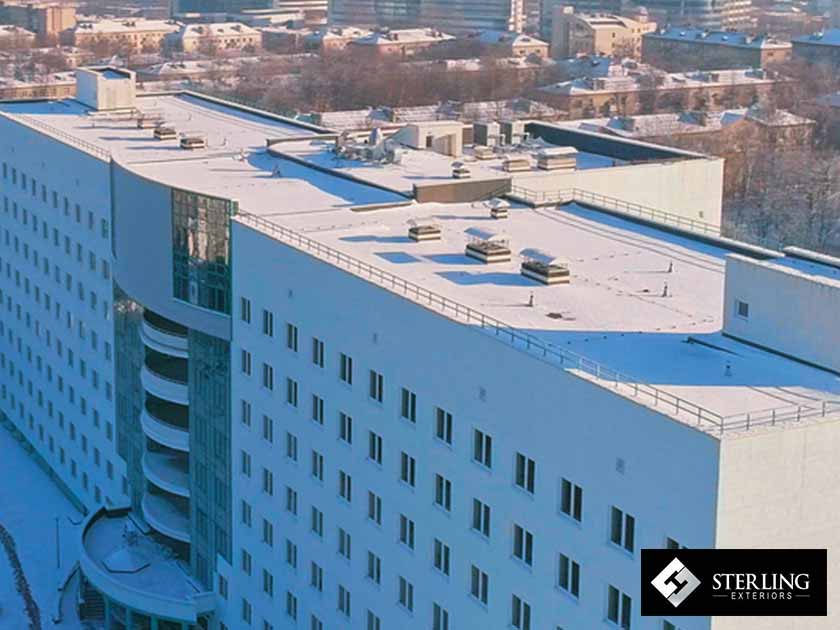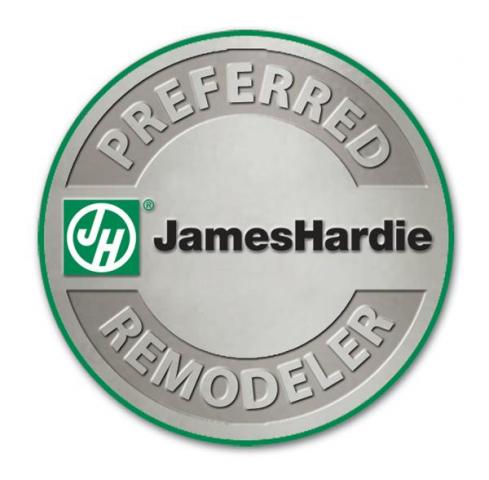During winter, you need to watch out for snow piling up on top of your commercial roofing system. While the snowfall may look pretty on your building, too much of it can affect your roof’s performance and structural integrity. Letting it sit on your roof for too long is ill advised for several reasons.

Low slope or flat roofs naturally accumulate more snow than steep-sloped roofs during the winter months. They can collect several feet of snow, which can block access to some of the building’s ventilation and drainage systems, as well as causing other problems if left unaddressed. This can lead to costly repairs that could have been avoided with proper care and maintenance.
By learning how to maintain your commercial roofing system, you can prevent too much snow accumulation. Just remember that proper snow removal should always be done by certified roofers for your safety. To understand what to expect in snow removal, Sterling Exteriors has the details:
Is It Always Necessary to Remove Snow?
In general, there’s no need to clear off the snow after every single snowfall. Most roofs are designed to tolerate a certain weight limit. If too much snow accumulates on top of your roof, it can become difficult to remove especially if it’s been there for too long.
Fortunately, most commercial roofing systems can handle a few inches of snow. The Federal Emergency Management Agency (FEMA) also states that snow accumulation is relatively normal, and it can even be riskier to clear off the snow rather than leave it. This is because improper snow removal can lead to roof membrane damage. Just make sure that the snowfall amount meets your local building codes and that the roof is regularly inspected by trusted professional roofers to ensure it’s in good condition!
Common Effects of Excess Snow on Roofs
Snow that has been on your roof for a certain amount of time can become packed and heavy. The newer layers of snowfall will slowly compact the older layers and make them denser over time. If snow continues to accumulate, it gets heavier per square foot compared to freshly fallen snow. The excess weight can easily surpass the limit of your commercial roofing system, which can lead to sag or even collapse if not addressed.
Other negative effects of excess snow on your commercial roof can include:
- Damaged Drainage System – Snow that sits too long on your commercial roof can melt and enter the drainage system. Although internal drainage systems are usually warm enough to prevent the water from refreezing, the same can’t be said if you have an external system. When the water refreezes, it can expand and cause damage to your system.
- Excess Snow and Icicles on Roof Edges – Snow and icicles can form on your roof’s edges, which can fall at any time and pose a risk to people and property. Icicles falling off the roof can cause injuries to people underneath. Snow and ice can also damage any type of property below it such as the roofing membranes on lower roof surfaces, which can lead to additional repair costs.
- Roof Membrane Damage – When the snow build-up constantly melts and refreezes on your commercial roofing system, it can cause damage to the roof membrane. During the day, the snow melts and works its way into the cracks within the membrane. When the temperature drops during nighttime, the snow refreezes and expands beneath the membrane. This deteriorates your roof membrane’s effectiveness in keeping out the weather elements and leads to water ponding, bowing, water leaks, and other roofing damage.
- Blockage – Excess snow on your commercial roof can easily block access to some of the main features and systems of your building. This can include plumbing/drainage systems, HVAC equipment, and even roofing vents. The excess snow can affect your system’s performance and cause it to work harder than necessary to maintain indoor air quality. This naturally leads to more energy consumption and therefore higher utility bills!
If you have too much snow, it can become difficult to even access the roofing system. This can happen after a fierce snowstorm that blocks your only access to the top of your building. When this happens, you’ll need to work with trusted roofing professionals who can find an alternative to get onto your commercial roof and remove the excess snow build-up.
Clearing the Excess Snow
If you think you have too much snow accumulating on your commercial roof, you need to consult with your roofer. Clearing snow should only be done by an experienced professional. If you try to do it yourself, you’ll only endanger yourself; one wrong step and you can slip have an accident. You’re better off leaving the job to experts who have the knowledge, experience and safety training to perform professional snow removal services.
Here’s what to expect from a professional snow removal job:
- Assessment: The roofing contractors will first inspect your roofing system and surrounding areas. They’ll remove any objects from around the perimeter of the building to prevent damage when they clear out the snow and ice. They’ll also mark off areas where people shouldn’t walk to prevent accidental injuries.
- Removal: Once everything’s ready, they’ll use a shovel to clear out as much of the excess snow as possible. They’ll be doing this evenly so that the weight won’t get too heavy on one side. They’ll also do this delicately to prevent scraping or digging into the roof membrane and other materials.
- Clean-Up: Once the bulk of the excess snow has been cleared out, they’ll start using a broom or a rake to remove the remaining snow left on your commercial roof. They’ll sweep the surface carefully and evenly to prevent accidental damage to the surface. They’ll also check your gutters and downspouts to clear out any snow build-up.
Sterling Exteriors offers only the best residential and commercial roofing maintenance services in the area. Contact us today at (513) 685-8055 or through our online request form! We serve Cincinnati, Loveland, Newtown and nearby OH areas.






